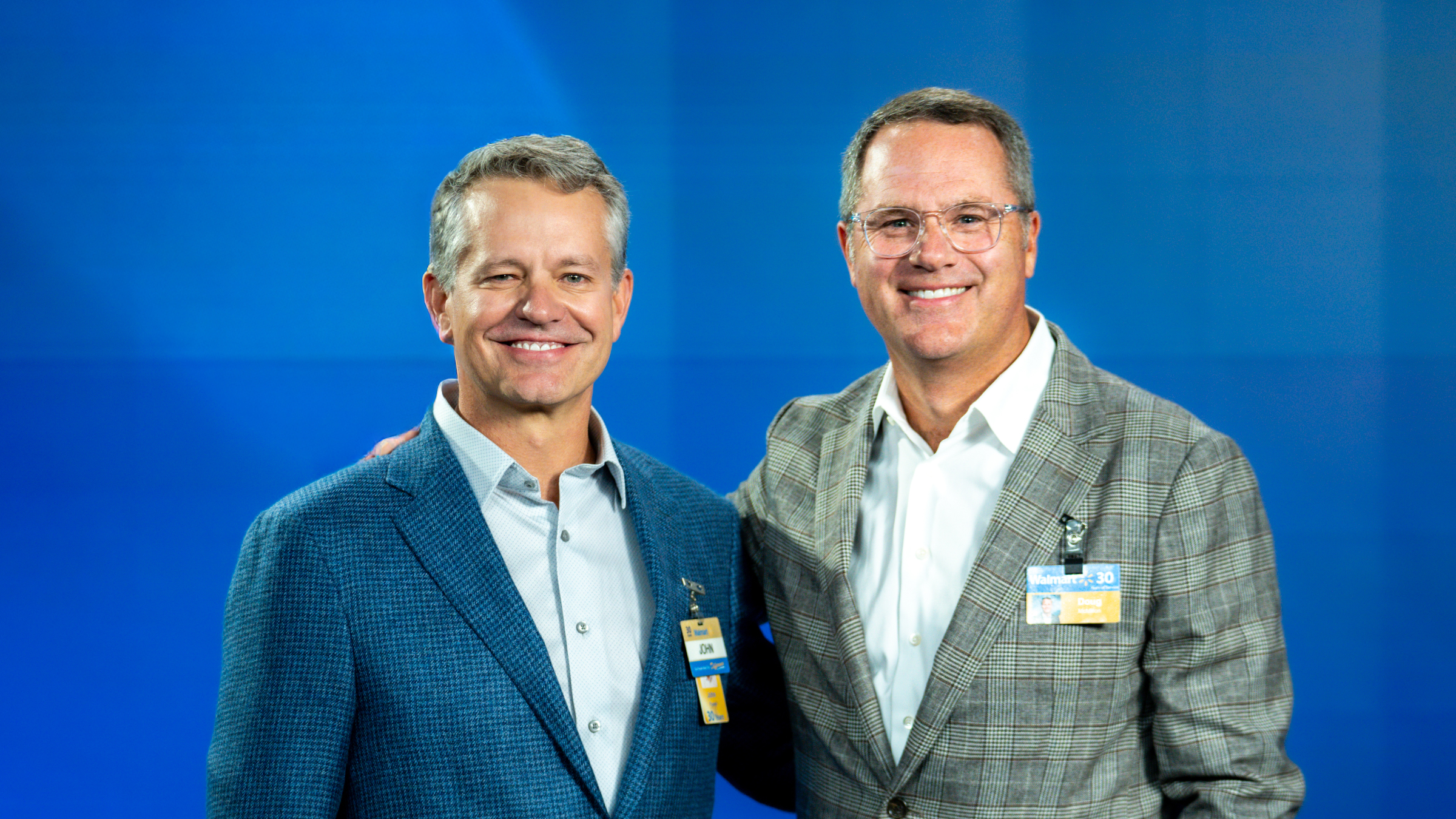
Photo courtesy of Walmart
November 14, 2025
Walmart’s Next CEO Era: From McMillon to Furner
Walmart Inc. announced that Doug McMillon, its CEO and president since 2014, will retire early next year, and be succeeded by current Walmart U.S. division CEO John Furner.
Furner, 51, was also elected to the company’s board of directors. McMillon, 59, will remain on the board until the next annual shareholders’ meeting in June 2026 and stay on as an advisor to Furner through January 31, 2027.
Under his 11-year term as CEO, Walmart’s shares have increased about four-fold.
Doug McMillon’s Tenure as Walmart CEO: Both Praise and Criticism
McMillon faced criticism for Walmart’s $3 billion acquisition of Jet.com and acquisitions of several digital start-ups — including Bonobos, Eloquii, and ModCloth — but earned credit for making Walmart a more meaningful online competitor to Amazon, including through its Walmart+ membership program and third-party marketplace. He’s also earned praise for investments in training and wages for store associates and managers, market share gains in grocery, increasing Walmart’s appeal to upper-income households, and managing numerous recent disruptions from the pandemic to supply chain bottlenecks, inflation, and tariffs.
Greg Penner, chairman of Walmart Inc., said, “Our family and Board have stated many times that Doug was uniquely qualified to be CEO at the necessary time for Walmart. Over more than a decade as CEO, Doug led a comprehensive transformation by investing in our associates, advancing our digital and eCommerce capabilities, and modernizing our supply chain, resulting in sustained, robust financial performance. He leaves Walmart stronger, more innovative, and better aligned with our purpose to help people save money and live better.”
John Furner: What Does the Future Hold For Walmart Under His Leadership?
Furner, starting at Walmart as an hourly associate in 1993, has held leadership roles across merchandising, operations and sourcing. He’s been leading Walmart’s U.S., the company’s largest operating segment, since 2019 after previously guiding Sam’s Club. His father was also an executive at the company.
He takes the reins of the nation’s largest private employer next February as retail navigates shifts caused by artificial intelligence and ongoing digital transformation, as well as likely continued anxiety over trade policies and geopolitical threats.
Penner said, “John’s six-year leadership of our Walmart U.S. business during a time of rapid change, marked by digital acceleration and strong associate engagement, has positioned us for continued success.”
McMillon said of Furner, “His curiosity and digital acumen combined with a deep commitment to our people and culture will enable him to take us to the next level. He’s uniquely capable of leading the company through this next AI-driven transformation.”
Furner said, “As we enter a new retail era fueled by innovation and AI, our purpose and our people will continue to guide us. Together, we’ll find new ways to serve customers, support our associates, and strengthen the communities we call home.”
Discussion Questions
What do you make of Doug McMillon’s legacy as Walmart’s CEO?
What advice would you have for John Furner?
Poll
BrainTrust
Tom Ryan
Managing Editor, RetailWire
Recent Discussions







Doug McMillon inherited a great business, and he leaves behind an even better business. That’s not an easy thing to accomplish, but Doug has managed it by focusing on customers, making good bets on things like online marketplaces and retail media, and executing well. His leadership also focused on creating an environment where people are not afraid to experiment and try new things. Fortunately, Walmart has a strong leader waiting in the wings in the shape of John Furner. John has done a great job heading up Sam’s Club and now the US business. He has big shoes to fill but is capable of filling them.
It is also worth saying that both Doug and John came up through the ranks. They know retail and Walmart inside out. And they care deeply about what the customer sees and how associates feel. Walmart is strong on operations, but is also strong on culture because it never loses sight of what really matters in retail!
In many ways, Furner and McMillon are similar on paper, having come up through the Walmart ranks and run multiple other businesses in the organization. However, the difference is in the leader they followed – Doug followed Mike Duke, an engineer turned operator. John is following Doug, a merchant turned operator. This means that John is inheriting a more balanced business, though it will be up to him to properly position Walmart as a true competitor to Walmart over the next decade.
That we’re still talking about WalMart in mostly positive terms (outside, of course, those who are predisposed to hate them, regardless), indeed that we’re still taking about them, period, means his tenure was a success.
Going forward WalMart will increasingly run into two problems (1) there’s another 800 lb gorilla in the cage; and (2) the cage isn’t going to get any bigger. This will compel them to try to get into other lines of business that they aren’t familiar with…and may not be good at.
What to make of Mr. McMillon’s legacy at Walmart? Look at the stock price. The company has performed well, as the article indicates. Now we usher in a new CEO, Mr. John Furner. It’s not like he’s coming in cold. He’s been practicing for years to be ready for this leadership role. Advice for Mr. Furner? Take advantage of whatever wisdom he hasn’t already learned from Doug McMillon. You don’t have to agree, but everything Mr. McMillon shares is worth paying attention to.
Doug McMillan’s legacy is Walmart’s metamorphosis from stores with low-cost leadership to the world’s most omnichannel retailer. By adapting to consumers’ evolving needs and steadfastly helping customers save money, McMillan helped Walmart attract shoppers spanning income levels and generational cohorts.
While Jet.com modernized Walmart with e-commerce, the Shopify partnership catapulted Walmart into the 2020s as an all-channel powerhouse. Investing in logistics, memberships and B2B services fortified Walmart’s e-commerce infrastructure and revenue drivers.